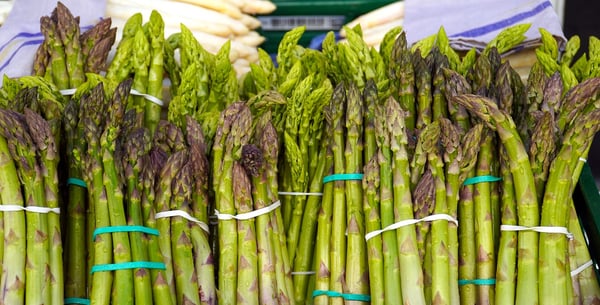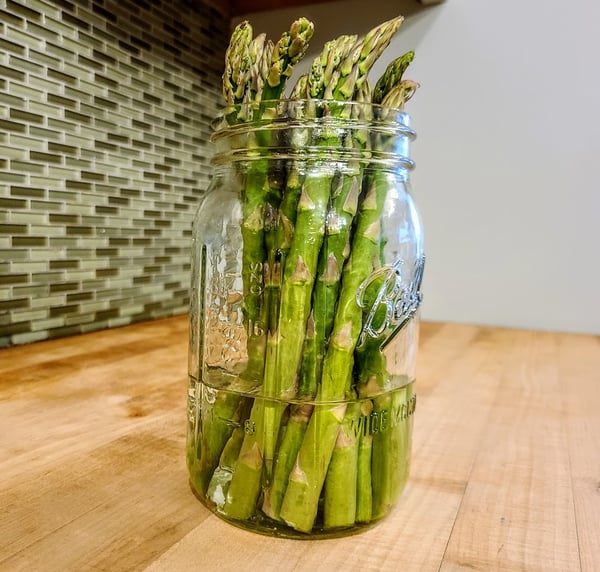Spring has arrived and with it comes one of my favorite vegetables: asparagus! While asparagus is luckily usually found year-round in grocery stores, like most produce, it has a peak season. You will find the best asparagus during spring. Asparagus season usually starts around late February and goes until June, but the peak months are in April and May.
There are many different varieties of asparagus but the three most widely found are green, white and purple. Most common and widely seen in the grocery stores is the green asparagus, which has a grassy, sweet and slightly bitter taste to it. White asparagus grows in the dark (hence the absence of color), but it tastes very similar to its green cousin. White asparagus can be very expensive and is considered a delicacy in Europe. Purple asparagus has high levels of anthocyanin, which is an antioxidant that gives it a purple color. It is also a very tender type of asparagus, much more so than its white and green counterparts, in part because of its lower fiber content. In addition, because it tends to have more sugar than other varieties of asparagus, it is also much sweeter in taste. Beside finding these varieties in the grocery store, asparagus is very much prevalent in the wild and can make for an amazing asparagus hunting adventure!

Choosing Asparagus
Fresh asparagus will be bright green with no signs of shriveling. The tender tips may have a purplish cast, but they should be firm and tight, never mushy. The cut end will be thick and fibrous. This end is cut off before cooking, but if the shoots are fresh, you may lose only an inch. Pro tip: if you bend the asparagus near the fibrous end, it will snap exactly where it needs to in order to only discard the unappealing part. You can save and freeze the ends and use them later in soup or in a stock. Be sure to always inspect your bundle of asparagus in the grocery store, the outer stalks may look beautiful but they could be hiding mushy stalks inside.
Storing Asparagus
Wash in cold water, snip off ends to give a fresh cut and place in small glass or mason jar with enough cold water to cover the ends and about 1/4 to 1/2 inch up the stem. Asparagus should always be stored in cold water so they won't dry out if possible. I like to keep them somewhere in the middle of my refrigerator, but they can also last for a few days out on your kitchen counter at room temperature.

Health Benefits
Eating this tender veggie is an excellent way to help protect yourself against heart disease, as it contains lots of folate, as well vitamins E, A, and C. In addition to helping your heart, folate (a B vitamin) helps cells regenerate; vitamin E fights Type II diabetes; and vitamins A and C help hold cancer and cataracts at bay. Asparagus also contains potassium, which helps lower blood pressure and perhaps even cholesterol.
Preparing Asparagus
Never overcook asparagus. I generally don’t speak in absolutes when it comes to cooking, but there is nothing worse than mushy asparagus. These amazing spears really do not take that long to cook no matter what method you are using.
What is truly amazing about asparagus is depending on how you decide to cook the asparagus, the final taste changes dramatically. If you choose a direct heat like sautéing, grilling or broiling the veggie you will get an earthy, slightly bitter and sweet flavor with a deeper green final color. If you were to choose a more delicate way of cooking like steaming, blanching or sous vide you end up with a brighter green shade with succulent and grassy taste.
Here is a list of my top five methods of cooking asparagus:
- Grilled
I love grilled asparagus! It is so easy and quick to make and, in my opinion, it tastes the best prepared this way. I am all about efficiency in the kitchen and just after your grilled meats come off the grill and during their 10-minute resting period, that is the time to grill your asparagus. The timing works out great; just as your meats are ready to be sliced and served up, your asparagus is beautifully charred and perfectly crisp-tender.
I set my grill with high direct heat with the door closed. Usually all it takes to make the asparagus shine is just a very light coating of oil to get the salt and pepper to stick but you can use any of your favorite spice blends. Place the seasoned spears on the hottest spot of the grill, perpendicular to the grates and cook for about 2-3 minutes or until you see a slight char on one side. If the asparagus stalks are skinny, pull them off the heat, if they are thicker, roll them over to char the other side. Once charred, plate them and finish with a balsamic glaze or fresh squeezed lemon juice or even grated Parmesan cheese.
- Raw
You may not know this, but you can eat asparagus raw. Shaving veggies allows them to become more tender but still maintain and highlight crispness. Shaving asparagus truly enables you to enjoy the entire stalk. You can achieve thin ribbons with a mandolin or a peeler. Even just thinly slicing your asparagus on a bias will cut through all of the fibers and give you an aesthetically pleasing end result. Shaved asparagus salads are such a great spring time treat and hold up really well for leftovers. My favorite combo would be shaved asparagus, fennel, red onions and radishes with a preserved lemon and feta vinaigrette.
- Sautéed
Over medium high heat in a large cast-iron pan with very minimal oil is how I like to sauté my asparagus. You may keep them in in their spear form or cut them down into 1-inch pieces for a wonderful accompaniment to your meal. Asparagus makes an excellent addition to stir fries and pasta dishes. I like to sauté my asparagus in its raw form, but it can also be blanched first in order to keep its bright green hue.
- Blanching
To blanch asparagus you will need to bring a pot of water to a boil and heavily season it with salt. You only need to cook the asparagus for about three minutes at the most, depending on the size of the stalk using this method. Once boiled they are ready to eat or it can be shocked in an ice bath to stop the cooking process. This maintains the bright green color and can be saved for future use on another day. You can then sauté, grill, or add the already cooked asparagus into a dish to rewarm, taking care not to overcook.
- Sous Vide
By cooking your asparagus sous vide, you ensure you won’t overcook the asparagus. You can also add different seasonings to the vegetable and all of that flavor stays in the bag! This is another gentle cooking method that preserves the bright color of the asparagus, just like steaming or blanching and it can then be eaten right out of the bag or finished with a secondary cooking method.
Asparagus-Leek Bisque with Crème Fraîche
Scroll down for a printable version of this recipe
Yield: 4-6 servings
Active time: 45 minutes
Start to finish: 45 minutes
1 bunch asparagus, cut into 1” pieces
4 tablespoons butter
1 small leek, white and tender green parts only, cut into medium dice and washed well
1 stalk celery, medium dice
2 cloves garlic, rough chopped
3 tablespoons all-purpose flour
4 to 5 cups chicken or vegetable stock, light concentration
2 sprigs fresh parsley
2 sprigs fresh thyme
1 bay leaf
1/2 cup heavy cream
1 to 2 teaspoons lemon juice
Salt and pepper to taste
Crème fraîche
- Bring a large pot of water to a boil and add a generous pinch of salt. Blanch the asparagus until crisp yet tender, 3-4 minutes, depending on the thickness. Shock the asparagus in a bowl of ice water. When cool, drain well and rough chop into smaller pieces. Set aside.
- Melt the butter in a large, heavy pot over medium heat. Gently sauté the leeks and celery until softened, 4 to 5 minutes. Add the garlic and cook an additional minute.
- Sprinkle in the flour and cook, stirring, for 2 additional minutes.
- Gradually whisk in the stock, and bring to a boil. Tie the parsley, thyme and bay leaf into a bundle with a piece of kitchen twine and add to the soup. Lower the heat, and simmer for 10 minutes. Remove and discard the herb bundle.
- Stir the blanched asparagus into the soup base and cook for an additional 6 minutes.
- Working in batches, transfer the soup to a blender, and puree until smooth.
- Return the pureed soup to the pot and reheat over medium heat. Whisk in the heavy cream and add the lemon juice to taste. Season with salt and pepper.
- Divide the bisque among warm soup bowls, top with a dollop of crème fraiche.
If you want to learn more about asparagus and how to prepare it in different ways, we have some great springtime menus coming up in-person on our Lincoln Square patio. We are offering two demonstration style classes featuring asparagus where you get to sit and enjoy the meal with drinks and watch as the chef prepares all of the dishes and teaches the process along the way. If you prefer a more hands-on style of learning, we have a wonderful Tapas on the Grill class where you get to cook your entire meal.
- Double Date: Hands-On Tapas on the Grill Saturday, May 15 6pm Lincoln Square
- Brunch Al Fresco: Demo on the Patio Sunday, May 30 11am Lincoln Square
Asparagus-Leek Bisque with Crème Fraîche
Ingredients
- 1 bunch asparagus, cut into 1” pieces
- 4 tablespoons butter
- 1 small leek, white and tender green parts only, cut into medium dice and washed well
- 1 stalk celery, medium dice
- 2 cloves garlic, rough chopped
- 3 tablespoons all-purpose flour
- 4 to 5 cups chicken or vegetable stock, light concentration
- 2 sprigs fresh parsley
- 2 sprigs fresh thyme
- 1 bay leaf
- 1/2 cup heavy cream
- 1 to 2 teaspoons lemon juice
- Salt and pepper to taste
- Crème fraîche
Instructions
- Bring a large pot of water to a boil and add a generous pinch of salt. Blanch the asparagus until crisp yet tender, 3-4 minutes, depending on the thickness. Shock the asparagus in a bowl of ice water. When cool, drain well and rough chop into smaller pieces. Set aside.
- Melt the butter in a large, heavy pot over medium heat. Gently sauté the leeks and celery until softened, 4 to 5 minutes. Add the garlic and cook an additional minute.
- Sprinkle in the flour and cook, stirring, for 2 additional minutes.
- Gradually whisk in the stock, and bring to a boil. Tie the parsley, thyme and bay leaf into a bundle with a piece of kitchen twine and add to the soup. Lower the heat, and simmer for 10 minutes. Remove and discard the herb bundle.
- Stir the blanched asparagus into the soup base and cook for an additional 6 minutes.
- Working in batches, transfer the soup to a blender, and puree until smooth.
- Return the pureed soup to the pot and reheat over medium heat. Whisk in the heavy cream and add the lemon juice to taste. Season with salt and pepper.
- Divide the bisque among warm soup bowls, top with a dollop of crème fraiche.
